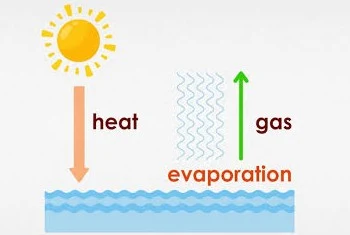Evaporation is an operation that is carried out in the industry as a means of concentrating a weak liquor/solution by vaporising a portion of the solvent. The weak liquor/solution is composed of a non-volatile solute and a volatile solvent.
Objective of Evaporation
The objective of evaporation is to concentrate a solution consisting of a non-volatile solute and a volatile solvent.
{tocify} $title={Table of Contents}
In this operation, the solvent to be evaporated is generally water and the concentrated solutions/thick liquor is the desired product. The vapour generated usually has no value, it is condensed and discarded.
It differs from drying in that the residue obtained is a liquid rather than a solid.
It differs from distillation in that the vapour is usually a single component and even if it is a mixture, it is not separated into fractions.
It differs from crystallization in that the purpose is to concentrate a solution rather than to form and build crystals.
Evaporation is generally followed by crystallization and drying.
Evaporation is carried by supplying heat to a solution to vaporise the solvent. The common heating medium is generally low-pressure steam but in some situations, other sources that might be used: are solar energy, fuel, electricity, hot oil and flue gas. This heat is utilised to-
(i) increase the temperature of the solution to its boiling point and
(ii) supply the latent heat of vaporisation of the solvent.
Though several rate processes occur (heat transfer from heating from a heating medium to a solution through the solid surface, simultaneous heat and mass transfer from a liquid to a vapour phase), the operation can usually be considered in terms of heat transfer from a heater to the solutions for the design of evaporator.
There is a wide variation in characteristics of the liquor to be concentrated that requires judgement and experience in designing and operating evaporations.
Properties of Evaporating
(i) Concentration
As the concentration increases, the solution becomes more and more individualistic. The viscosity and density increase with solid content. The boiling point of the solution also increases considerably with the solid content so that it may be much higher than solution also increases considerably with the solid content so that it may be much higher than the boiling point of water at the same pressure.
(ii) Foaming
Some materials have the tendency to foam which causes heavy entertainment (carryover of a portion of the liquid by the rising vapour is called entrainment).
(iii) Scale
Some solutions deposit scale on the heat transfer surface which results in a reduction of the heat transfer coefficient and hence the heat transfer rate. It is therefore necessary to clean the tubes at definite intervals.
(iv) Temperature sensitivity
Some materials especially pharmaceutical and food products are damaged when heated to moderate temperatures even for short times. For concentrating such materials special techniques are to be used to reduce the temperature and also the time of heating.
(v) Materials of construction
Generally, evaporation is made of mild steel. Whenever contamination and corrosion are not a problem special materials such as copper, nickel, and stainless steel may be used. Other liquid characteristics that must be considered in the design are specific heat, freezing point, toxicity, explosion hazards and radioactivity.
The selection of an evaporator for a particular application is based on the analysis of factors such as the properties of the liquid to be concentrated, operating cost, capacity, hold-ups and residence time. High product viscosity, heat sensitivity, scale formation and deposition are the major problems encountered during the operation of evaporators and should be taken into account while designing an evaporator for a new installation.
Usually, the desired product of an evaporation operation is the concentrated solution (called thick liquor), but occasionally the evaporated solvent is the primary product as in the evaporation of seawater to obtain potable water.
Take these Notes is, Orginal Sources: Unit Operations-II, KA Gavhane

